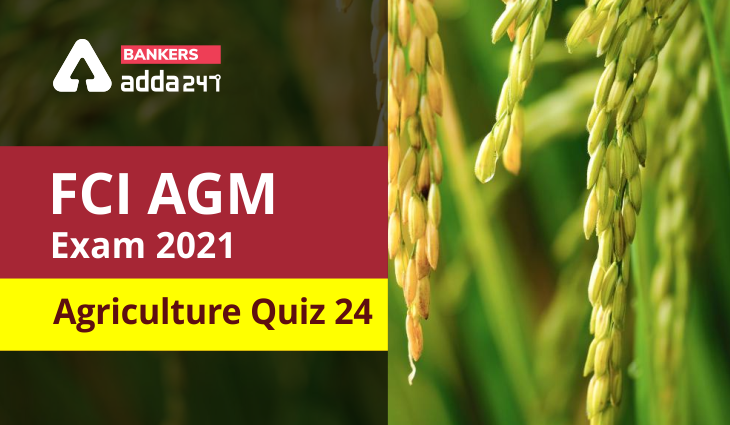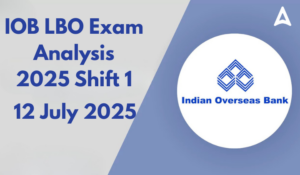FCI Recruitment 2021: Good News for all the aspirants, Bankers Adda team is coming up with Exclusive Questions of Agriculture for FCI AGM 2021 on the Adda247 app also, so download the Adda247 App now to attempt these quizzes. We have started this series on 18th March 2021. So, do attempt it daily from today and crack the FCI AGM 2021 Exam.
Q1. Who is known as “Father of Hybrid Rice”?
- William S. Gaud
- Prof. Long Ping Yuan
- Dr. Gurdev Singh Khush
- Dr. M. S. Swaminathan
- None of these
Explanation:- Yuan Longping was a Chinese agronomist, member of the Chinese Academy of Engineering, known for developing the first hybrid rice varieties in the 1970s, part of the Green Revolution in agriculture. For his contributions, Yuan is known as the “Father of Hybrid Rice“.
Q2. Growing plants under soil-less condition is called
- Terra- farming
- Precision farming
- Hydroponics
- Contour farming
- None of these
Explanation:- Hydroponics is a type of horticulture and a subset of hydroculture that involves growing plants (usual crops) without soil, by using mineral nutrient solutions in an aqueous solvent.
Q3. Source of greenhouse gases
- Deforestation
- Methane gas from paddy field & livestock
- Nitrous oxide from N base fertilizer
- All of the above
- None of these
Explanation:- Globally, the primary sources of greenhouse gas emissions are electricity and heat (31%), agriculture (11%), transportation (15%), forestry (6%), and manufacturing (12%). Energy production of all types accounts for 72 percent of all emissions.
Q4. Effect of global warming on agriculture
- Drought in a warmer region
- Increase sea level resulting in submerging of coastal areas.
- Cause changes in climate tremendously
- All of the above
- None of these
Explanation:- Climate change can affect agriculture in a variety of ways. Beyond a certain range of temperatures, warming tends to reduce yields because crops speed through their development, producing less grain in the process. And higher temperatures also interfere with the ability of plants to get and use moisture.
Q5. Most widely used for correcting soil
- Gypsum
- Lime
- Urea
- Ammonium carbamate
- None of these
Explanation:- Limestone, burnt lime, or slaked lime can be used to correct the acidity of the soil. Lime increases phosphorus, nitrogen, potassium, and molybdenum content in the soil. In such soil, a white layer of salts is commonly seen on the surface.
Q6. NABARD was set up on the recommendation of
- M.S. Swaminathan committee
- Mohan Singh Mehta committee
- Ashok Mehta committee
- Siva Raman committee
- None of these
Explanation:- NABARD was established on the recommendations of B. Sivaraman Committee (by Act 61, 1981 of Parliament) on 12 July 1982 to implement the National Bank for Agriculture and Rural Development Act 1981.
Q7. Post-harvest losses for cereals account for
- 15%
- 12%
- 6%
- 25%
- None of these
Explanation:- A country-wide study measuring crop losses revealed that 3.9% – 6% cereals, 4.3%-6.1% pulses, 2.8%- 10.1% oilseeds, 5.8%-18.1% fruits, and 6.9%-13% vegetables were lost during harvesting, post–harvest activities, handling and storage.
Q8. Example of erosion permitting crop
- Rice
- Wheat
- Bajra
- Linseed
- None of these
Explanation:- Erosion permitting crops– cotton jowar, bajra, etc. The erosion resisting crops– groundnut, matki, hulga (Dolichos biflorus), soybean.
Q9. In water erosion 3 m deep, more than 18m wide gully is known as
- Small gully
- Large gully
- Very small gully
- Deep gully
- None of these
Explanation:- In water erosion, 3 m deep, more than 18m wide gully is known as small gully erosion.
Q10. Cultivation of two of more than two crops of different heights simultaneously on a certain piece of land in a certain period is called
- Relay Cropping
- Multistoried Cropping
- Parallel Cropping
- Inter Cropping
- None of these
Explanation:- Growing plants of different heights in the same field at the same time is termed as multi-storied cropping. It is mostly practiced in orchards and plantation crops for maximum use of solar energy even under high planting density.
Also Attempt:




 GA Capsule for SBI Clerk Mains 2025, Dow...
GA Capsule for SBI Clerk Mains 2025, Dow...
 The Hindu Review October 2022: Download ...
The Hindu Review October 2022: Download ...
 IOB LBO Exam Analysis 2025, Shift 1 Ques...
IOB LBO Exam Analysis 2025, Shift 1 Ques...


